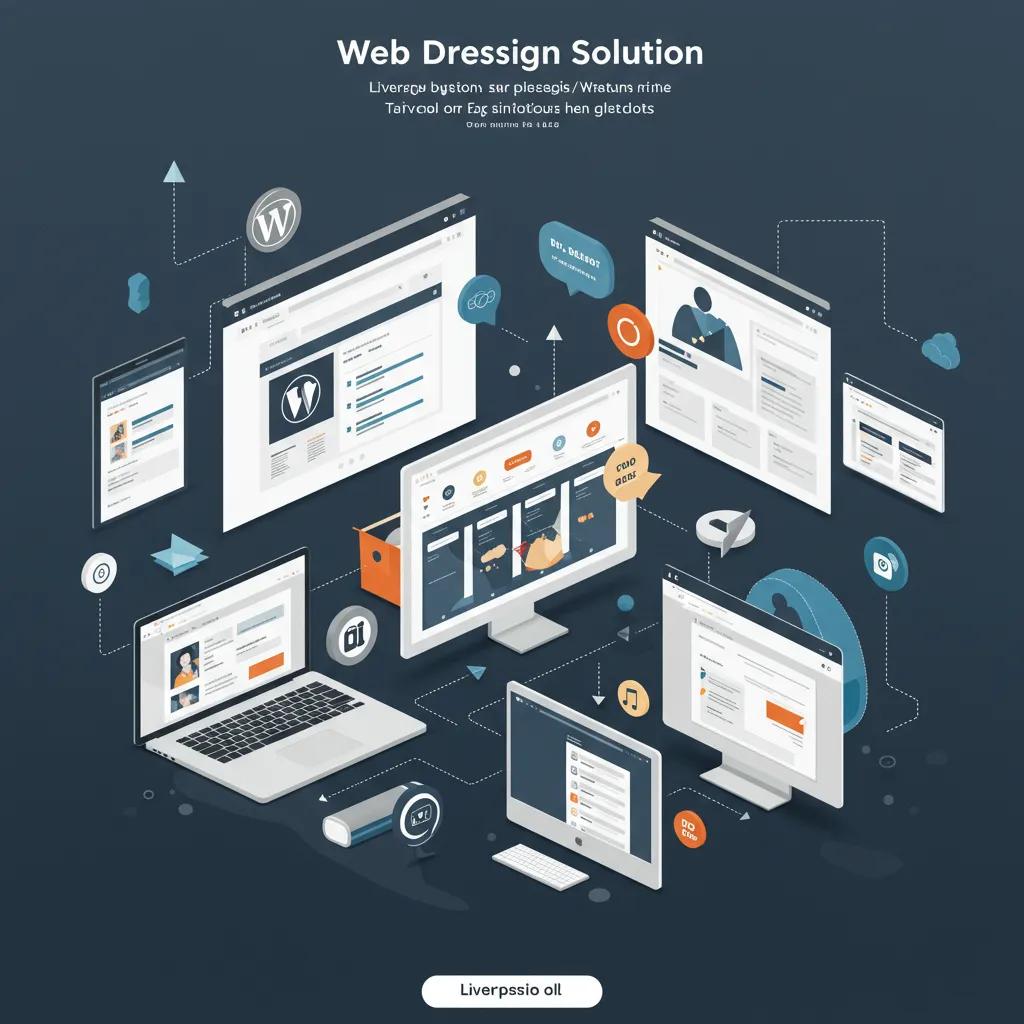
Liverpool Web Design Agency: Expert Website Development and SEO for Lead Generation
Liverpool web design combines local market knowledge, conversion-focused website development, and targeted SEO to help service businesses generate measurable leads and win contracts. This article explains how Liverpool web design works as a system—how site structure, local SEO, UX, and lead capture mechanics convert visitors into qualified quote requests for facilities maintenance and commercial cleaning firms. Many Liverpool service businesses struggle to turn enquiries into recurring contracts because their websites are generic, slow, or lack clear quote flows; the right web design solves those problems by reducing friction and prioritising lead qualification. You will learn which services a local agency typically offers, the specific lead-generation features that matter for facilities and cleaning companies, practical affordable package approaches, mobile-first and accessibility essentials, the role of AI and personalisation, the typical project process, and the KPIs to measure return on investment. Throughout this guide, we use target concepts such as Liverpool web design, lead generation website design, commercial cleaning website development, and local SEO for cleaning companies to show actionable steps you can use right away.
What Services Does a Liverpool Web Design Agency Offer?
A Liverpool web design agency offers a set of interlocking services designed to improve visibility and capture more qualified leads by combining technical build, content, and local search strategies. These services work together: bespoke design creates user trust, responsive development preserves performance, CMS setups allow rapid updates, and SEO aligns pages with local buyer intent so searchers find the business when they need a cleaner or maintenance contractor. The result is a website that not only looks professional but also guides visitors toward requesting a quote or calling for contract work. Below is a focused inventory of core services typical for service-industry clients and how each ties directly to lead generation.
A typical service inventory includes the following practical offerings:
- Bespoke website design that aligns branding with buyer trust and conversion goals.
- Responsive web development (mobile-first) to reduce friction on on-the-go searches.
- Content Management System setup (e.g., WordPress) for rapid content updates and service pages.
- Local SEO and citation management to improve local pack visibility and organic enquiries.
- Lead capture systems: online quote request forms, contact flows, and CRM integrations.
These services are complementary: a conversion-optimised layout without local SEO will underperform, and strong SEO without an effective quote form can still lose leads. Understanding how each component contributes to conversions leads naturally to examining bespoke design advantages.
How Does Bespoke Web Design Benefit Liverpool Businesses?

Bespoke web design for Liverpool businesses means tailoring visual identity and user flows to local buyer expectations, which builds trust and accelerates decision-making. A bespoke approach ensures service pages speak directly to procurement cycles for facilities maintenance and commercial cleaning, emphasising contract experience, safety, and compliance where relevant. Mechanically, this increases time-on-page and click-through to quote forms, improving the likelihood of a completed enquiry and faster qualification. For example, a landing page that highlights contract capabilities and includes a short quote form will reduce bounce and raise qualified lead rates. This local alignment also supports local SEO efforts by enabling targeted content that mirrors how Liverpool organisations search for service partners.
What Website Development Solutions Are Available in Liverpool?
Website development solutions offered in Liverpool typically span template-driven CMS builds, managed WordPress sites, and bespoke custom builds, each with trade-offs around speed-to-market and scalability. Template or theme-based builds are cost-effective and deliver essential lead capture quickly, while managed WordPress offers more flexibility for integrations like CRM, quote calculators, and booking systems. Bespoke custom builds deliver performance and unique UX but require more investment; they are ideal when integration with enterprise CRMs or complex quoting systems is necessary. Choosing the right stack depends on a business’s growth plan: early-stage cleaning firms often benefit from a modular CMS, whereas large facilities managers may require bespoke integrations for contract tracking.
How Does SEO Web Design Improve Local Lead Generation?
SEO web design merges technical performance, structured data, and local content strategy to place service pages in front of local buyers when they search for cleaning and maintenance contracts. The mechanism involves optimising site speed, mobile experience, and schema (LocalBusiness, Service) while creating service-specific landing pages and localised content that match intent. This approach raises organic visibility and increases the volume of relevant, high-intent visitors who are likely to request quotes. Implementing strong on-page SEO alongside citation consistency and review management results in measurable uplifts in local traffic and enquiry volume, which in turn justifies further optimisation and content investment.
How Can Liverpool Web Design Drive Leads for Facilities Maintenance and Commercial Cleaning?
Web design drives leads for facilities maintenance and commercial cleaning by combining clear service scoping, trust signals, and friction-minimised enquiry flows that turn local visitors into qualified quote requests.
The mechanism is straightforward: service-specific pages capture intent, prominent CTAs and simplified quote forms reduce friction, and CRM integration ensures rapid follow-up that converts enquiries into contracts. The measurable benefit is an increase in qualified quote volume and faster lead-to-contract cycles when these elements are implemented together.
Below is a comparison of common lead-generation features and their conversion impact to help prioritise implementation.
Lead-generation features compared by conversion impact:
| Feature | Attribute | Typical Conversion Impact |
|---|---|---|
| Online quote form | Progressive fields + conditional logic | High |
| Service-specific landing pages | Localised content + schema | High |
| Trust signals (case studies, reviews) | Social proof + detailed outcomes | Medium-High |
| Click-to-call buttons | Mobile-first contact action | Medium |
| CRM integration | Rapid lead routing and scoring | High |
This table shows that combining quote forms, service pages, and CRM integration delivers the strongest impact; next, we look at concrete feature lists and CTAs that implement these mechanisms.
Web design implementations typically include the following conversion mechanisms:
- Clear service scoping on dedicated pages that reflect contract lengths and procurement needs.
- Prominent, thumb-friendly CTAs and click-to-call options tailored for mobile users.
- Short, conditional online quote forms that capture enough detail to qualify leads without creating friction.
Used together, these mechanisms reduce enquiry latency and increase conversion rates; the next section examines the key features in more detail.
What Are the Key Features of Lead Generation Websites for Facilities Management?
Lead generation websites for facilities management prioritise scannable service pages, scope checklists, case studies, and an easy path to request a quote or contact operations. The core mechanism is to present the service scope clearly so procurement teams can self-qualify before contacting you, which raises lead quality. Typical features include service landing pages for each offering, downloadable specification checklists, case study summaries with measurable outcomes, and visible accreditation icons. These elements increase trust and time-on-page, making visitors more likely to complete quote forms or call directly. Effective placement of these features near CTAs creates a streamlined path from discovery to enquiry.
How Do Online Quote Request Forms Increase Conversion Rates?
Online quote forms increase conversion rates by reducing friction through progressive disclosure, optimising required fields, and using conditional logic to ask only relevant questions. The mechanism is to gather just enough information to route the lead and trigger an immediate follow-up while minimising abandonment. Practical tips include starting with postcode and service type, offering optional attachments, and providing instant estimate ranges where possible. Integrating forms with CRM systems and automated replies ensures fast response and higher qualification rates. A/B tests should compare short vs longer forms and measure submit-to-contract conversion to identify the optimal balance.
The effectiveness of online quote forms is directly tied to their ability to streamline the user journey and gather necessary information efficiently.
Website Feature Quality for Lead Generation and Conversion
High-quality website features can attract, engage, and convert more visitors into online users and customers. The well-established process of Visitor Acquisition leads to increased website traffic. A thorough understanding of Online User Behaviour facilitates comprehension of online users’ intentions regarding their needs, wants, and desires on website pages. Conversion Rate Optimisation enhances the conversion of online users, thereby increasing the Conversion Rate to achieve business success.
Investigating website features quality using three online techniques on the lead generation website-a case study, 2020
Why Is Local SEO Critical for Commercial Cleaning Websites in Liverpool?

Local SEO is critical because most clients for commercial cleaning and facilities maintenance search locally and favour nearby vendors they can vet quickly; therefore, visibility in local packs and organic results directly drives enquiries. The mechanism combines GBP/GBP-equivalent optimisation, consistent citations, and service-specific local landing pages to match proximity and intent signals. Practical tactics include optimising local schema, collecting structured reviews, and creating tailored neighbourhood pages for Liverpool districts. These actions increase click-through rates from local searches and deliver more high-intent visits that convert into quote requests and contract discussions.
After explaining how these features work, it is useful to consider implementation priorities and budget-conscious options for smaller service firms while preserving conversion performance.
What Makes Affordable Web Design in Liverpool Effective Without Compromising Quality?
Affordable web design works when it focuses on an MVP (minimum viable product) that prioritises lead generation features and staged enhancements rather than attempting a fully bespoke build from day one. The mechanism is staged development: launch with essential service pages, a responsive template build, and a high-converting quote form, then iteratively add integrations like CRM and AI personalisation as budget permits. The benefit is a faster path to measurable leads and a clear ROI that can fund future improvements. Below is a compact comparison of package options to help choose the right procurement path for small service businesses.
Package comparisons for affordable web design:
| Package Level | Included Features | Price Band Guidance |
|---|---|---|
| MVP Starter | Template CMS, 3 service pages, quote form, mobile optimisation | Low |
| Growth Bundle | Customised template, 5–8 service pages, basic local SEO, CRM integration | Medium |
| Contract Ready | Bespoke design, CRM & quoting integration, case studies, full local SEO | Higher |
This table clarifies that prioritising conversion essentials in an MVP delivers early leads, while growth and contract-ready packages add integrations that improve lead qualification and contract win rates. Practical procurement steps follow.
How Can Small Service Businesses Access Cost-Effective Web Design?
Small service businesses access cost-effective web design by adopting a staged approach, using proven templates for core pages and investing first in lead capture and local SEO. The mechanism is to de-risk the project: launch quickly with a mobile-first template, prioritise service pages and online quote capabilities, and allocate budget for monthly optimisation based on performance. Steps include selecting a CMS that allows in-house updates, defining the minimal content set needed to convert, and planning phased integrations for CRM or scheduling. This approach reduces upfront cost while ensuring the website starts generating leads immediately.
For many businesses, the website is not just a digital brochure but the primary engine for acquiring new clients.
Online Lead Generation: The Website’s Central Role in B2B
The primary objective in online lead generation is to persuade website visitors to convert into leads. The website has assumed a central role in B2B lead generation. Consequently, for many companies, the website serves as the principal lead generation tool.
Online Lead Generation in B2B Marketing: The Role of Conversion Design on the Corporate Website, 2020
What Are the Trade-Offs Between Price and Features in Liverpool Web Design?
Price versus features trade-offs centre on speed-to-market, ownership, and long-term scalability; cheaper templated sites deliver fast lead capture but less customisation, while bespoke sites offer unique UX and complex integrations at higher cost. The mechanism is balancing short-term conversion needs against long-term growth: if the priority is immediate enquiries and quote volume, a well-optimised MVP is often preferable. Conversely, organisations bidding for large contracts may need bespoke workflows and CRM integrations that justify the higher investment. Understanding required integrations and expected lead volumes helps choose the most cost-effective path.
Why Is Responsive and Mobile-First Design Essential for Liverpool Service Industry Websites?
Responsive, mobile-first design is essential because a majority of local service searches occur on mobile devices, and a mobile-optimised site reduces friction for users seeking immediate quotes or contact details. The mechanism is simpler interactions: click-to-call, streamlined forms, and thumb-friendly CTAs that lower abandonment and increase submissions. The direct benefit is higher mobile conversion rates and better search performance since page speed and mobile usability are ranking signals. A practical checklist and mobile patterns help ensure the design supports prompt enquiries and local discovery.
Mobile-first design delivers three practical benefits for service firms:
- Faster access to contact methods like click-to-call and appointment booking on the go.
- Simplified content hierarchy that exposes key services and CTAs without scrolling overload.
- Improved search performance due to mobile speed and usability optimisation.
These benefits explain why mobile-first is not optional for cleaning and maintenance websites; the next subsections detail UX and accessibility practices.
How Does Mobile-First Design Improve User Experience for Facilities and Cleaning Services?
Mobile-first design improves UX by placing primary contact actions and service scoping near the top of the viewport, so busy facility managers can request a quote within seconds. The mechanism is prioritising essential tasks—postcode entry, service selection, and contact—so users complete micro-conversions quickly. Examples include large CTAs, reduced navigation complexity, and immediate access to testimonials or certifications that build trust. Improved UX decreases drop-off and increases the rate of qualifying leads from mobile visitors.
What Are Thumb-Friendly Design Practices for Service Websites?
Thumb-friendly design practices place primary CTAs within comfortable reach, use sufficiently large touch targets, and avoid dense menus that cause mis-taps and frustration. The mechanism is ergonomic layout: buttons sized to recommended touch dimensions, spacing that prevents accidental clicks, and simplified top-level actions like “Get a Quote” or “Call Now”. Practical guidelines include using 44–48px minimum touch targets, positioning CTAs within lower third reach on mobile, and limiting primary actions to one or two per screen. Implementing these patterns reduces friction and improves form completion rates on devices commonly used by decision-makers.
How Does Accessibility Compliance Impact Liverpool Web Design?
Accessibility compliance expands market reach and reduces legal risk by ensuring websites are usable by people with disabilities; the mechanism is following WCAG basics such as keyboard navigation, alt text, and adequate contrast, which improves usability for all visitors. The benefit includes increased potential client reach and better UX metrics, which can indirectly boost conversions. Recommended steps include auditing colour contrast, labelling form fields clearly, providing skip links, and testing with assistive technologies to ensure the site serves a wider Liverpool audience.
How Do Liverpool Web Designers Incorporate AI and Personalisation in Website Development?
Liverpool web designers incorporate AI and personalisation to increase engagement and fast-track lead qualification through features such as chat assistants, dynamic content, and predictive forms that tailor the experience to the visitor. The mechanism uses visitor signals—location, behaviour, and service interest—to surface relevant offers and reduce time-to-quote. The result is higher engagement and more accurate lead routing that supports sales teams converting enquiries into contracts. Below are practical AI-driven features and their conversion relevance for service businesses.
Key AI-driven features and benefits:
- Chat assistants that qualify leads and schedule follow-ups automatically.
- Instant quote calculators that give provisional estimates based on user inputs.
- Personalised CTAs that adapt to visitor location and prior interactions.
These features improve responsiveness and qualification; the following subsections expand specific examples and dynamic content uses.
What AI-Driven Features Enhance Lead Conversion on Service Websites?
AI-driven features that enhance conversion include conversational chatbots for initial triage, smart scheduling that checks crews’ availability, and instant quoting tools that provide preliminary estimates to users. The mechanism is automated qualification: chatbots ask targeted questions, collect contact details, and feed leads into CRM systems with priority flags. Expected benefits include faster response times, higher form completion rates, and improved lead qualification. Implementations should respect privacy and data rules, using minimal required data to initiate contact and escalate promising leads to human follow-up.
How Does Dynamic Content Improve Engagement for Facilities and Cleaning Businesses?
Dynamic content improves engagement by showing location-specific offers, highlighting relevant case studies for the visitor’s sector, and resurfacing previously viewed services to returning users. The mechanism personalises content based on attributes like postcode, industry type, and visit history, increasing relevance and decreasing bounce. Examples include offering a free site survey banner for users in Liverpool or surfacing municipal cleaning case studies when visitors indicate public-sector interest. A/B testing these rules helps determine which personalised messages generate the most quote requests.
What Are the Steps in the Liverpool Web Design Process for Service Industry Clients?
The Liverpool web design process for service industry clients follows clear phases—discovery, design and prototyping, development and launch, then optimisation—with each phase focused on reducing time-to-lead and improving lead quality. The mechanism ensures the build aligns to KPIs such as quote volume and conversion rate from the outset, so every deliverable contributes to measurable outcomes. Typical milestones include a discovery brief, wireframes, a working prototype, QA, and a controlled launch with tracking enabled. The next subsections unpack brief development, timelines, and revision management.
How Is the Design Brief Developed for Facilities Maintenance and Cleaning Companies?
Design briefs for facilities maintenance and cleaning companies capture services offered, target customer profiles, procurement cycles, and required integrations such as CRM or quoting tools; the mechanism is to define measurable goals like quote volume and target conversion rates. A practical brief includes sections for service descriptions, desired customer types (e.g., property managers, local authorities), compliance needs, and content assets like case studies. This focused brief reduces scope creep and ensures the resulting site supports lead generation from day one. Well-constructed briefs speed up design decisions and guide content prioritisation.
What Does the Website Development Timeline Look Like?
Typical timelines vary by project scope: an MVP template-based site can launch in 4–6 weeks, a growth bundle in 8–12 weeks, and a bespoke contract-ready build in 12–20 weeks depending on integrations and approvals. The mechanism is staged delivery with agreed review cycles for design, content, and testing to avoid delays. Key milestones include discovery, design sign-off, development sprints, QA, and a soft launch followed by optimisation. Built-in post-launch optimisation ensures tracking and iterative improvements to boost lead quality over time.
How Are Client Feedback and Revisions Managed?
Client feedback is managed through structured revision rounds, collaborative tools (prototype comments, annotated designs), and a clear change-request process to maintain scope control and timelines. The mechanism is to limit included revision rounds (for example, two rounds during design and one during QA) and use centralised tools to capture comments, which reduces miscommunication. Clear sign-off stages and version control enable the team to progress without rework, ensuring that project momentum leads to on-time launches and immediate lead capture capabilities.
How Can Liverpool Businesses Measure the Success of Their Web Design Investment?
Measuring success requires mapping KPIs such as quote conversion rate, organic local traffic, and lead quality to measurement tools like GA4 and CRM systems so results translate into clear business outcomes. The mechanism involves event-based tracking for form submissions, phone call tracking, and lead scoring in CRM to connect online enquiries to contract wins. The benefit is a data-driven view of ROI that informs iterative improvements. Below is a practical KPI-to-tool mapping to guide measurement setup.
KPI-to-tool mappings to monitor ROI:
| KPI | Recommended Tool | Typical Use |
|---|---|---|
| Quote conversion rate | GA4 + form event tracking | Measure submit rate from service pages |
| Organic local traffic | Google Search Console / local SEO tools | Monitor keyword & landing page performance |
| Phone call volume | Call tracking / CRM | Attribute calls to campaigns and pages |
| Lead quality / contract wins | CRM | Track lead source to closed business |
| UX behaviour (heatmaps) | Hotjar or similar | Identify friction points and improve forms |
This table shows how combining analytics and CRM data closes the loop from visit to contract, enabling informed optimisation and proving web design ROI. For service businesses seeking direct help, a final note on available support follows.
What Key Performance Indicators Are Used for Lead Generation Websites?
Key KPIs include quote request conversion rate, contact form submissions, organic local traffic, time on service pages, and lead-to-contract conversion; each KPI shows a different aspect of funnel health. The mechanism is to track both volume (submissions) and quality (contract wins) to avoid optimising for low-value leads. Benchmarks vary by sector, but tracking trends and conversion rates offers actionable insights to improve copy, CTAs, or form flows. Regularly reviewing these KPIs ties web activity to commercial outcomes and guides the next optimisation steps.
A robust understanding of Key Performance Indicators is crucial for evaluating the effectiveness of any lead generation website.
Website Optimisation for Lead Generation and Revenue Growth
Currently, their primary source of new clients is via their website, as it has proven to be the most effective channel after trials of others, and digital marketing is demonstrably highly impactful in contemporary practice. To enhance sales and facilitate the growth of PT. LVC, their website requires optimisation to generate leads, or potential customers, thereby ultimately increasing revenue.
Enhancing PT. LVC Website Marketing Strategy To Generate Leads Through Conversion Rate Optimization (CRO), AR Qastharin, 2024
How Does Local SEO Impact Liverpool Web Design Results?
Local SEO impacts results by increasing the visibility of service pages in the local pack and organic listings, which yields higher-intent visitors and more quote requests. Mechanically, consistent citations, localised landing pages, and review management improve local signals that search engines use to rank businesses for geographically relevant queries. The result is measurable increases in organic local traffic and often higher conversion because users selecting local results have immediate service intent. Monitoring local rankings and review volume provides early indicators of SEO performance.
What Tools Help Monitor Website Performance and User Behaviour?
Recommended monitoring tools include GA4 for traffic and conversion events, Google Search Console for query performance, heatmapping tools for UX insights, and CRM systems for lead tracking; the mechanism links behavioural metrics to business outcomes. These tools reveal where visitors drop off, which pages drive quote submissions, and how leads progress through commercial processes. Combining web analytics with CRM data provides a single view of return on investment and helps prioritise technical fixes or content updates to increase qualified enquiries.
For facilities maintenance and commercial cleaning firms seeking a direct performance review, specialised consultation and quote request services are available that offer a free website review and actionable recommendations tailored to service-industry lead generation.
Requesting a review will provide a prioritised list of fixes focused on increasing qualified quote requests and improving local search visibility.


